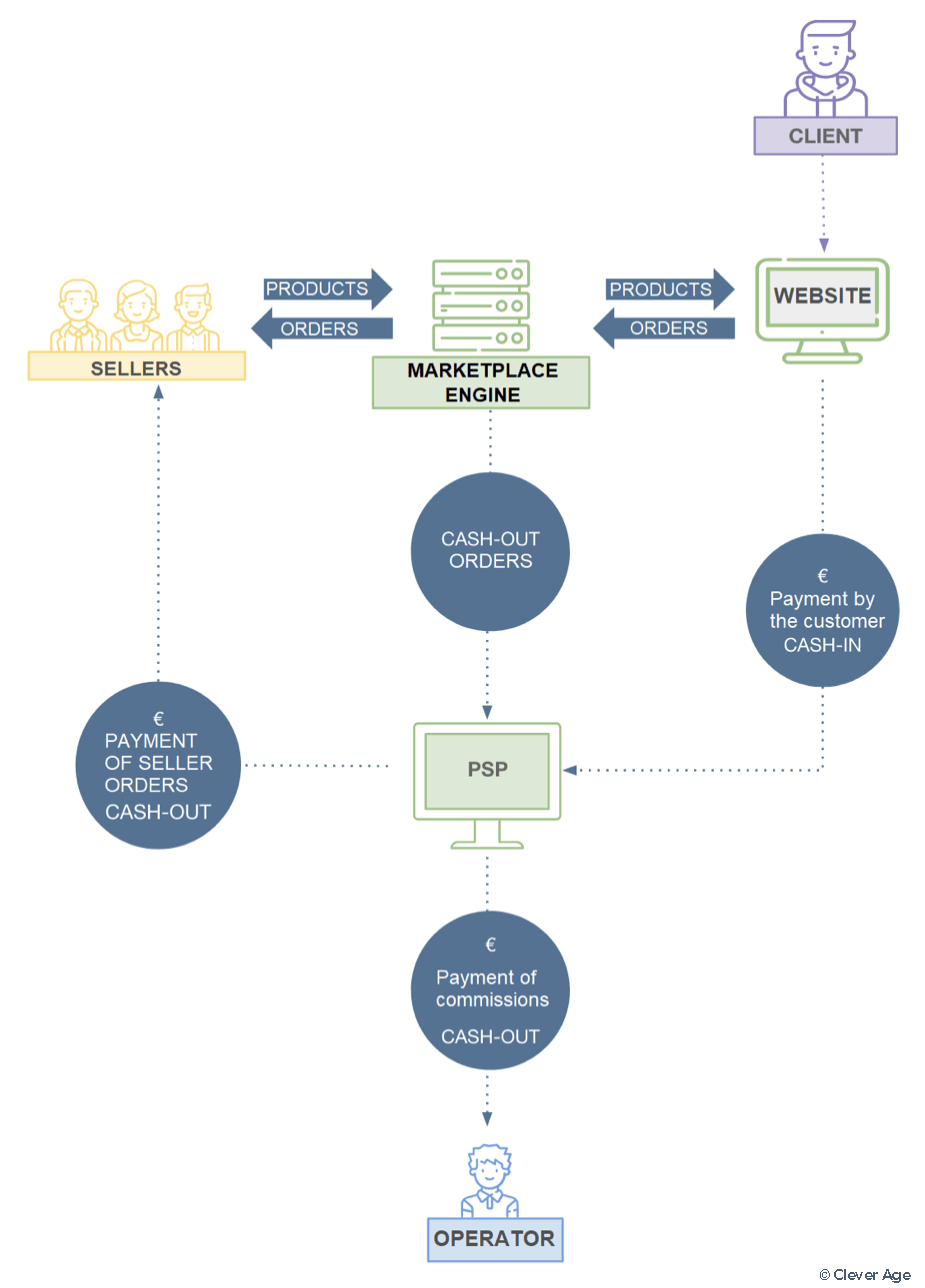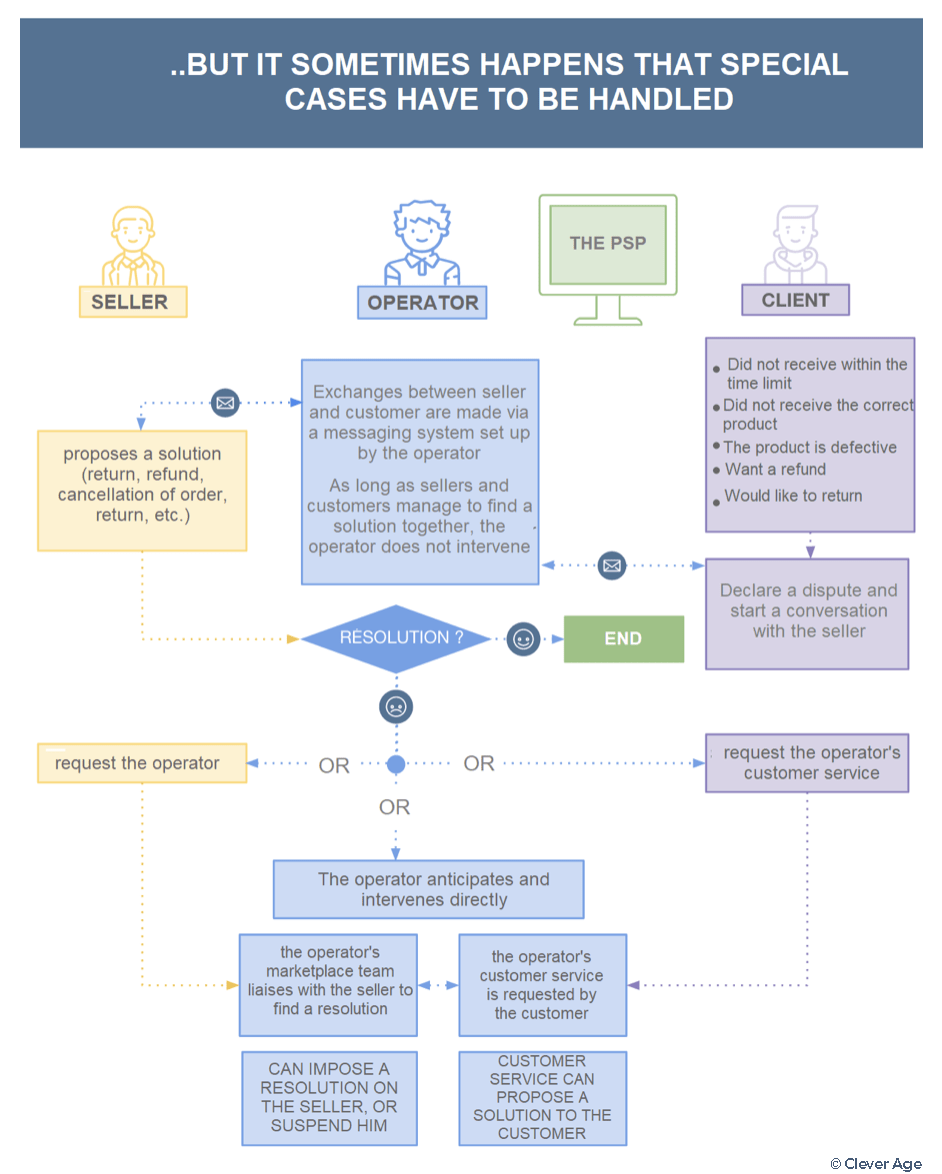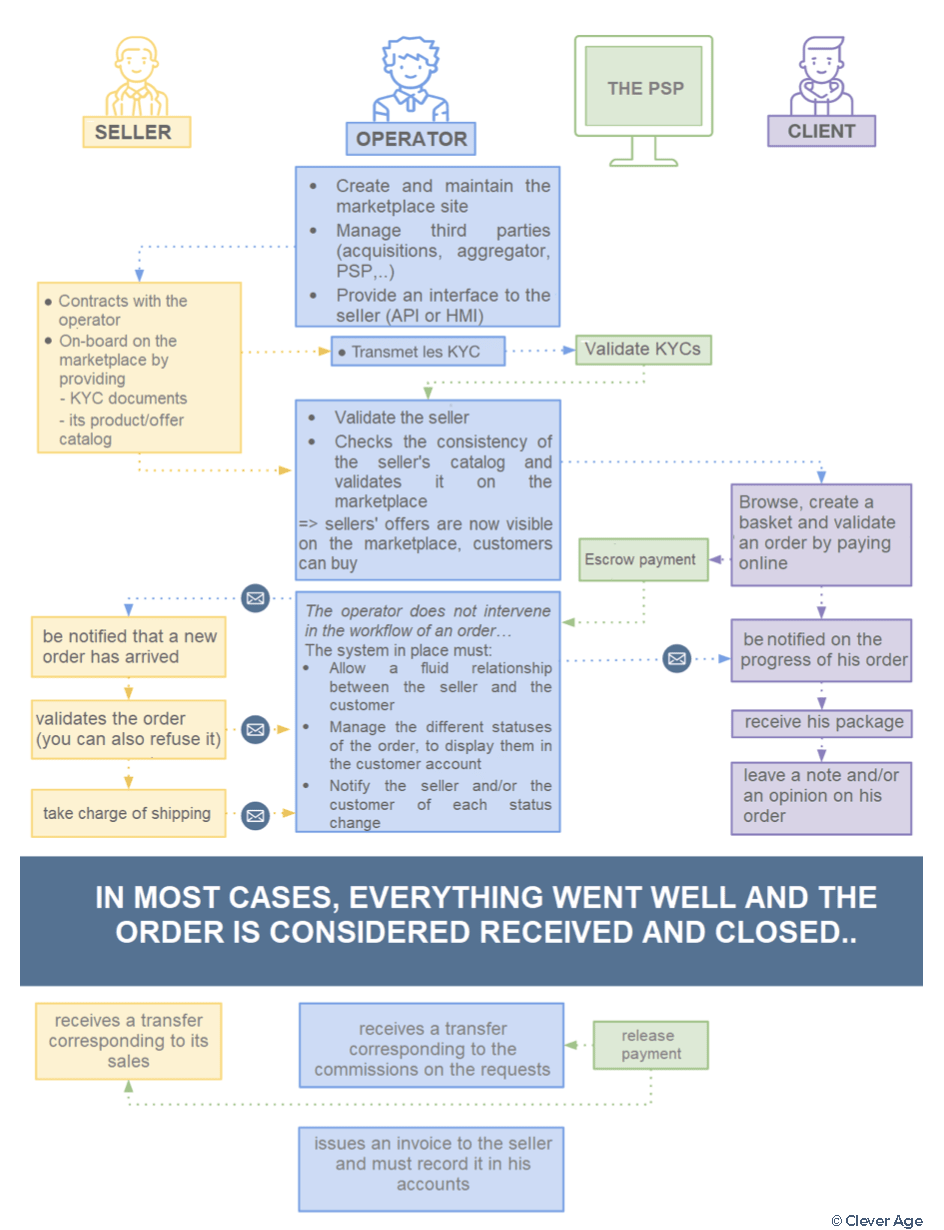INTRODUCTION
The subject of marketplaces is vast and a single article can never be enough to address all the points we want to share with a satisfactory level of detail.
This first episode is therefore the pilot of a series to be discovered over the coming weeks. This is an ambitious series whose objective is to allow you to approach as many aspects of a marketplace project as possible with, of course, a practical and pragmatic vision of its implementation.
MARKETPLACE – EPISODE #1
THE MAIN PRINCIPLES FOR APPROACHING A MARKETPLACE PROJECT
Summarize this in one article ? … This will be our goal !
A summary inevitably leads to dead ends, we will come back in detail with other articles to focus a little more in depth on certain aspects of a marketplace integration project.
In the following articles, we will go deeper into all these topics :
- The technical integration of a marketplace in my IS and on my e-Commerce site
- Merchant onboarding
- Product/offer/order/vendor flows
- Aggregators
- The legal
- KYCs, PSP
- Accountability
- The connectors
- Types of marketplace solutions (modules / Saas solutions / without coding)
- Fulfillment by
- Budgets to plan for a marketplace project
MARKETPLACE VOCABULARY
In the preamble we share some vocabulary elements for a better understanding of the rest of the article :
- The marketplace : it is the website, the e-commerce site, the showcase seen by visitors to make their purchases online.
- The marketplace engine : it is the application brick that will allow commercial intermediation between customer, seller and operator
- The operator : this is the company responsible for the marketplace. The operator takes care of managing the site, on-boarding sellers, ensuring the notoriety of the marketplace
- Sellers : these are the merchants who publish their catalog on the marketplace, who collect orders and get paid for them. (“vendors” = “merchants”)
- Cash-in : this is what the customer pays on the marketplace for his online purchases
- Cash-out : There are 2 different cash-out flows : the funds returned to sellers for all the sales they have made on the marketplace, and the funds paid to the operator for the commission that it takes on sales
- The PSP (Payment Service Provider) : is the payment system that allows a customer to pay, by credit card, in one go, an order made up of products from several different sellers
- KYC (Know Your Customer) : These documents (the “KYC documents”) and the KYC procedure are there to ensure the identity of the merchant (in order to prevent identity theft, tax evasion, money laundering of money or the financing of terrorism). By “Customer”, we mean here the merchants who market their products on the marketplace and not the end buyers.
Many other terms are used specifically in the context of marketplace projects. They will be detailed in future articles.
WHAT IS A MARKETPLACE ?
DEFINITION
A marketplace is above all an e-commerce site, an online sales site.
The particularity of a marketplace compared to a “simple” e-commerce site lies in the fact that it is multi-vendor.
It is therefore a question, when operating a marketplace, of being able to manage the three-way relationship (Client/Operator/Seller).
- The operator sets up the site (the showcase)
- The seller offers his products and/or services and collects orders
- The customer can shop
The 3 find an interest in it :
- The customer has access to a very extensive catalog, with attractive prices
- The seller takes advantage of the operator’s reputation to reach more customers
- The operator increases its traffic, its number of customers, and generates new turnover by receiving a commission on the sales of its sellers (the operator then issues an invoice to the seller for these commissions)
To ensure this three-party intermediation, it is necessary to rely on a technical brick (the Marketplace engine) which makes it possible to :
- Manage multi-vendor catalogs
- Take and manage multi-vendor orders
- Break down the financial flows to the sellers and the operator
To operate a marketplace, we will therefore have at least :
- An e-commerce site
- A marketplace engine (some e-Commerce platforms include a marketplace engine)
- A payment system : the PSP. Note : The PSP must be approved to collect on behalf of third parties, a subject to which we will return in a future article.

THE DIFFERENT TYPES OF MARKETPLACE
The term Marketplace is sometimes used to refer to platforms or services that provide an intermediary activity in the context of :
- Purchasing platforms
- Connecting platforms
- Lead generation
- Offers
As familiar as we are with these types of projects, we will remain, within the framework of the articles presented here, on a more “classic” context :
- A seller publishes a catalog of offers (he manages his prices, his stocks, his shipments)
- A seller picks up orders through an operator’s storefront
- The operator is paid with a commission on the cash that passes through. This type of remuneration is the most common, but other models are possible for the operator : sale of services to sellers, subscriptions to have access to the marketplace, commissions on logistics if this service is offered by the operator to sellers, …
Once these assumptions have been made, it is necessary to distinguish between different types of marketplaces :
- The B2C Marketplace
This is the type of marketplace that we know the most as an individual who makes his purchases on the Internet (FNAC, Amazon, Manomano, etc.). Many major brands of e-commerce, distance selling, vertical specialists, etc. have been launched for several years. - The B2B Marketplace
The B2B marketplace (Amazon Business, DirectIndustry, CDiscount Pro, etc.), just like B2B e-commerce, will have to embed specific B2B functionalities : multi-user business accounts, price systems by slices/by customers, quotes, … and above all the most complex : payment on the due date. As you will have understood, if the marketplace model is based on a commission taken from a financial flow, when the payment for an order is split into several payments, and/or on a flow that is out of sync with the action of purchase, recovering the commission can be a nightmare. - The C2C Marketplace
More and more big brands want to launch their C2C marketplace. Very often it is second-hand platforms like Easycash for example (but not only). A brand will, for example, allow individuals to sell second-hand products (of its own brand or others) on its site. The model can then vary to “remunerate” the particular seller : in vouchers or in cash.
Marketplaces can also be categorized in terms of what they sell :
- Product Marketplace
We buy physical products (which we have delivered) or virtual products (which we download). - Service Marketplace
Services are purchased there. Once the purchase has been validated, there is a specific workflow for each service to schedule (diary) the service, and then validate that the service has been carried out so that the service provider is paid. - Hybrid marketplace : products AND services
If the history of marketplaces began with C2C with advertising and auction platforms (LeBonCoin, eBay, etc.), it is B2C marketplaces that have been the focus of all attention since the arrival of Amazon of course, and other major e-commerce sites that have developed their “in-house” marketplaces.
And it is also over the past ten years that we have seen many players flourish on the market who offer their solution to motorize a Marketplace on an e-commerce : these solutions, generally available in SaaS, have become very mature ( for some anyway) and capable of managing very large marketplaces with very large volumes (several million products).
In the continuity of the evolution of B2B e-Commerce, the future should give pride of place to B2B marketplaces thanks to the development of increasingly mature and industrialized technical solutions.
WHO DOES WHAT ON A MARKETPLACE ?
Ideally, when all goes well, the operator does not intervene in the life of an order placed on the marketplace.
The operator must therefore make every effort to ensure that this act of ordering goes well and that its automation is maximum : in the case of an order that goes wrong (dispute between a customer and a salesperson for example) the operator must be able to intervene as a mediator.
The diagram below shows the main events in the life of a marketplace, as well as the scope of actions of the different parties.

In summary, the operator must :
- Make every effort to ensure that the order and the relationship between customer and seller are done without his intervention
- Make every effort to help customers and vendors manage contentious cases
A MARKETPLACE PROJECT FOR MY COMPANY, WHAT DOES IT IMPLY ?
Assuming that you are already a recognized and experienced e-merchant, a marketplace project is an important change that turns the whole company upside down (especially if you do not already have e-commerce under your skin).
Indeed, when you become a marketplace operator, all of the company’s services will be impacted and new resources will be needed :
- A dedicated team
Account managers to manage and operate the marketplace on a daily basis and provide support to your sellers, customer service agents dedicated to three-party management (disputes, returns, invoicing, etc.) - The commercial field
Your salespeople are new types of customers. Business development is specific and generally addressed by business developers dedicated to this activity who will now target future sellers much more than end customers. - Legal
It will be important to involve the legal as soon as possible on the responsibilities that you take as an operator of a marketplace, the contractualization with the sellers, your general conditions of sale, the RGPD, … - Purchases
They will be responsible for a coherent overall offer containing your own products (if you also sell your own) and those of multiple third-party sellers. - Accountability
The commission taken on sales, and possibly a subscription that you would charge your sellers, is a new turnover to take into account. It is necessary to plan for an evolution of the accounting rules which are a little specific (collection on behalf of third parties, invoicing of commission, etc.) - The technique
Integrating a marketplace brick into your e-commerce ecosystem is not trivial. Beyond the integration project, the entire infrastructure may need to evolve to ensure performance of course (with a marketplace you will have more volume of traffic data, more technical flows, more third parties – Lengow or Shoppingfeed type feed aggregators, ….-), monitoring (more applications, more dependencies) and security (a platform much more open to external parties – sellers – than a simple eCommerce site) ! - The data
New indicators are to be taken into account for your reporting in terms of web analytics, volume of data (products, sales, sellers), the turnover of the marketplace which corresponds to the commissions charged, and the volume of business which is the overall volume of all site sales. - Marketing, merchandising, search, acquisition
Quelles règles doivent présider à la mise en avant d’un produit vendu par plusieurs marchands ? Est-ce que je traite de la même manière les produits des vendeurs et les miens (dans les listings produits, les mises en avant, les flux sortants, …) ? - Client service
An important change is to be accompanied so that the agents know how to respond and direct a customer request as much as possible towards the sellers, so that you only intervene at level 2, as a mediator in the event of a dispute between the customer and the seller.
IN SUMMARY
As in any project, the marketplace can be divided into 2 main phases :
1 – The Build – Preparing your marketplace :
- Create the technical platform :
- Integrate the Marketplace engine into my e-commerce and my IS
- Parameterize
- Integrate third parties (PSP, Aggregators, …)
- Legal framework
- Prepare support for change in the company
- Recruit the marketplace team
- On-board the first merchants
2 – The Run – Operate your marketplace :
- Management of marketplace specificities on e-commerce :
- Specific rules for search/merchandising/animations,
- Consistency of vendor products with the overall offer,
- Opening of new categories,
- Level 2 customer service to manage disputes,
- MP business development (new merchants, new services, etc.)
- Day-to-day management of vendors :
- Support for merchants in their integration into your marketplace (integration of catalogs via API, file exports, FTP, mapping)
- The rules for suspending accounts,
- Monitoring of KYC files,
- Verification of the conformity of the visuals produced with the charter,
- Proposals for commercial operations,
Knowing that in the end, the secret of the overall success of a marketplace project lies in 3 main axes :
- A coherent business strategy
- Controlled technical integration : consistency of solutions, architecture and technologies, resources, timing and budget
- The adhesion of the whole company to the project

